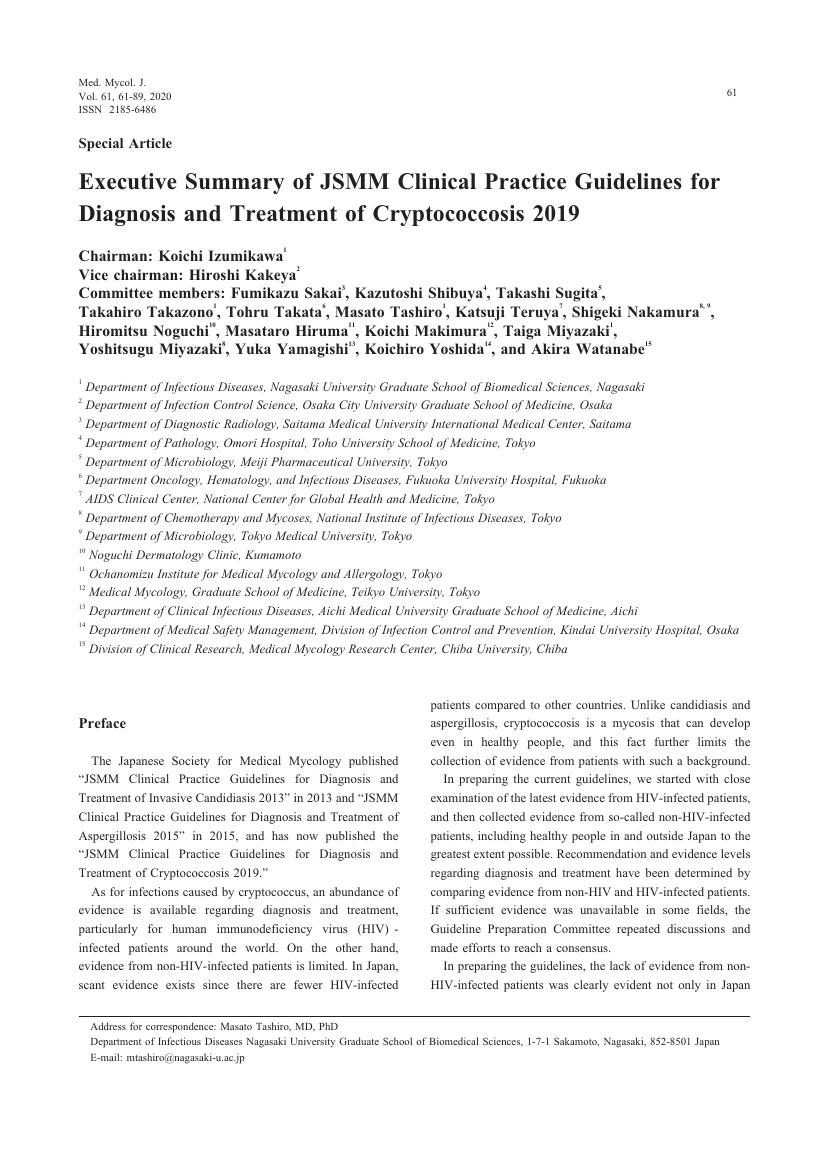- 著者
- Hiroki Namikawa Koichi Yamada Hiroki Fujimoto Ken-Ichi Oinuma Yoshihiro Tochino Yasuhiko Takemoto Yukihiro Kaneko Taichi Shuto Hiroshi Kakeya
- 出版者
- 一般社団法人 日本内科学会
- 雑誌
- Internal Medicine (ISSN:09182918)
- 巻号頁・発行日
- vol.56, no.14, pp.1807-1815, 2017-07-15 (Released:2017-07-15)
- 参考文献数
- 37
- 被引用文献数
- 18
Objective In recent years, infection caused by extended-spectrum beta-lactamase (ESBL)-producing organisms has become an important issue. However, comparative studies of the bacteremia caused by ESBL Enterobacteriaceae and non-ESBL Enterobacteriaceae are extremely rare in Japan. This study aimed to assess the risk factors and prognosis of patients with bacteremia due to ESBL Escherichia coli (E. coli). Methods The medical records of 31 patients with ESBL E. coli bacteremia and 98 patients with non-ESBL E. coli bacteremia who had been admitted to Osaka City University Hospital between January 2011 and June 2015 were retrospectively reviewed. The patient backgrounds, risk factors for infection, and prognosis were evaluated. Results The male-to-female ratio, mean age, underlying disease, leukocyte count, and C-reactive protein (CRP) level did not differ between the patients in the ESBL E. coli bacteremia and non-ESBL E. coli bacteremia groups. The mean Sequential Organ Failure Assessment (SOFA) score for patients with ESBL and non-ESBL E. coli bacteremia were 3.6 and 3.8, respectively. Further, the mortality did not differ between the two groups (9.7% vs 9.2%). However, the independent predictors associated with ESBL E. coli bacteremia according to a multivariate analysis were the use of immunosuppressive drugs or corticosteroids (p=0.048) and quinolones (p=0.005) prior to isolation. The mortality did not differ between the carbapenem and tazobactam/piperacillin (TAZ/PIPC) or cefmetazole (CMZ) groups for the patients with ESBL E. coli bacteremia. Conclusion Whenever we encountered patients with a history of immunosuppressive drug, corticosteroid, quinolone administration, it was necessary to perform antibiotic therapy while keeping the risk of ESBL E. coli in mind.
- 著者
- Hiroshi Kakeya
- 出版者
- The Japanese Society for Medical Mycology
- 雑誌
- Medical Mycology Journal (ISSN:21856486)
- 巻号頁・発行日
- vol.63, no.1, pp.11-15, 2022 (Released:2022-02-28)
- 参考文献数
- 37
- 被引用文献数
- 2
In clinical settings, the number of immune compromised patients have increased as a result of developments in medical technology (e.g., organ transplantation, anticancer drugs, steroids, TNF inhibitors, etc.). However, patients with fungal diseases are also increasing globally. In recent years, the distribution and pathogenicity of fungi worldwide have been changing, with reports that new fungi are emerging, and antifungal-resistant fungi are spreading globally. Global warming, globalization, human activities, and other factors have been suggested as contributing to the emergence of new fungi. Some of the antifungals against which resistant fungi have emerged are commonly used not only for human but also for animal health care and crop protection. Consequently, the occurrence of antifungal-resistant fungi has become a clinical issue. Solving these problems entails continuing the “One Health” approach, which in turn requires updating medical mycology information with regard to the emerging pathogenic fungi. In particular, this paper reviews the recent information on Cryptococcus gattii, Candia auris, and azole-resistant Aspergillus fumigatus.
- 著者
- Koichi Izumikawa Hiroshi Kakeya Fumikazu Sakai Kazutoshi Shibuya Takashi Sugita Takahiro Takazono Tohru Takata Masato Tashiro Katsuji Teruya Shigeki Nakamura Hiromitsu Noguchi Masataro Hiruma Koichi Makimura Taiga Miyazaki Yoshitsugu Miyazaki Yuka Yamagishi Koichiro Yoshida Akira Watanabe
- 出版者
- The Japanese Society for Medical Mycology
- 雑誌
- Medical Mycology Journal (ISSN:21856486)
- 巻号頁・発行日
- vol.61, no.4, pp.61-89, 2020 (Released:2020-11-30)
- 参考文献数
- 39
- 被引用文献数
- 7
- 著者
- Koichi Yamada Hiroki Namikawa Hiroki Fujimoto Kiyotaka Nakaie Etsuko Takizawa Yasuyo Okada Akiko Fujita Hiroyoshi Kawaguchi Yasutaka Nakamura Junko Abe Yukihiro Kaneko Hiroshi Kakeya
- 出版者
- 一般社団法人 日本内科学会
- 雑誌
- Internal Medicine (ISSN:09182918)
- 巻号頁・発行日
- vol.56, no.7, pp.781-785, 2017-04-01 (Released:2017-04-01)
- 参考文献数
- 27
- 被引用文献数
- 21
Objective Coagulase-negative staphylococci are among the most frequently isolated microorganisms in blood cultures. The aim of this study was to assess [1] the clinical characteristics of methicillin-resistant, coagulase-negative staphylococci bacteremia and [2] the susceptibility of the isolated bacteria to glycopeptides. Methods We retrospectively reviewed the medical records of 70 patients from whom methicillin-resistant coagulase-negative staphylococci had been isolated at Osaka City University Hospital between January 2010 and December 2013. We evaluated the patients' background, severity and prognosis of the disease, and the susceptibility of the isolated methicillin-resistant coagulase-negative staphylococci to glycopeptides. Results Out of the 70 patients tested, 28 (40.0%) had leukemia, and 36 (51.4%) had been treated for febrile neutropenia. Infection with Staphylococcus epidermidis accounted for 78.6% of patients. Thirty-nine cases (55.7%) were related to intravascular catheters, and 39 (55.7%) were treated using teicoplanin as a first-line therapy. The 30-day mortality rate was 4.3%. Regarding susceptibility, 20% of all isolates were non-susceptible to teicoplanin. According to multivariate analyses, it was observed that premedication using glycopeptides was independently associated with teicoplanin non-susceptibility (p=0.03; hazard ratio = 5.64; 95% confidence interval, 1.16-26.76). Conclusion Our results suggest that clinicians must use glycopeptides appropriately to prevent the development of further antibiotic resistance in methicillin-resistant coagulase-negative staphylococci.
